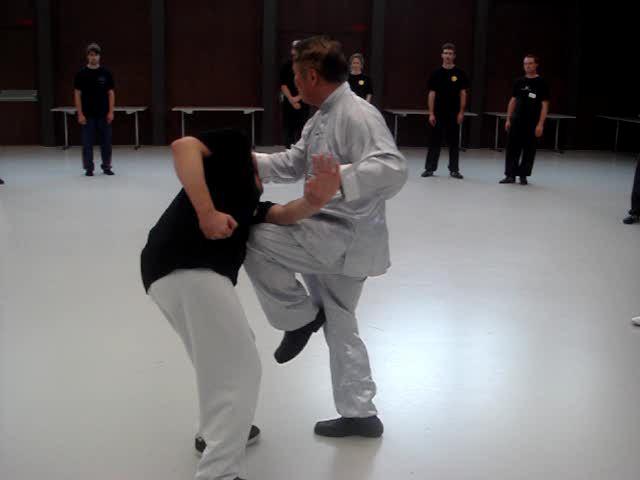VARIOUS KUNGFU STYLES IN OUR SCHOOL

"Hook Hand Raise Knee" in Praying Mantis Kungfu
Question 5
What made you decide to teach the Five Animal Play now?
What are the typical movements and sounds of the specific animals?
Evelyn
Answer
Like many other interesting courses, I decided to teach the Five-Animal Play because the organizer, Adalia, suggested it to me. She said that the Five-Animal Play was interesting, and many people would be interested in it, and asked me whether I would teach a course on it. I agreed with what she had suggested, and so the Five-Animal Play would be added to our list of courses, starting in Barcelona in May 2014. Students who liked the Five-Animal Play would have to thank Adalia.
Daniel from Barcelona then asked me whether I would be ready to answer questions on the Five-Animal Play. Again I agreed. So, we have to thank Daniel for our increased understanding of the Five-Animal Play.
This trend is the same with the other interesting courses, which greatly increased our repertoire, making our school a treasure hours of important arts in chi kung, kungfu and Zen.
In 2010 Adalia also asked me whether I would teach Bone-Marrow Cleansing. Markus from Finland also asked me independently whether I could conduct a series of courses on the Legacy of Bodhidharma, which included the 18 Lohan Hands, Sinew Metamorphosis and Bone-Marrow Cleansing. He also suggested a course on Iron Wire. I said, “Very good, carry on.” So these wonderful arts have become a part of our rich repertoire.
In the same year, Roland suggested Praying Mantis Kungfu to be taught in a regional kungfu course in Bern. I chose the Eighteen Collection to be the basic set in the Praying Mantis Course as this set incorporated the best 18 techniques of the time Wang Lang, the inventor of Praying Mantis Kungfu, collected from his friendly sparring with many masters all over China. I also taught the 18-Lohan Art which Northern Shaolin masters employed for their internal force training.
The first introduction of other kungfu styles, besides Taijiquan, into our school which was established to preserve mainly Southern Shaolin, was Tantui, the fundamental of Northern Shaolin in 2007. I can’t remember whether it was Emiko who first proposed it, or it was introduced by myself, seeing that many practitioners in Toronto were Tantui practitioners.
Emiko proposed that I taught Wing Choon. So the first Special Wing Choon Course was held in Penang in 2010.
Robin came up with a brilliant idea of the Drunken Eight Immortals. So we had a Drunken Eight Immortal Course at the UK Summer Camp in 2011 too. Following this brilliant idea, Robin continued to propose Baguazhang and Xingyiquan, to complete the trilogy of the internal arts of Taijiquan, Baguazhang and Xingyiquan. So Baguazhang was conducted at the UK Summer Camp in 2012 and Xingyiquan in 2013.
Andrew proposed Wuzuquan, the one remaining art of my four sifus that I had not taught in our school. For some reason, this course was not held in Switzerland, but I conducted a Special Wuzuquan Course in Penang in 2012.
Innovation is a key factor for growth and success. It is no surprise that our school has successfully grown to be the largest martial art and chi kung school in the world in all history. We have a lot of innovative people.
As its name reveals, there are five animals in the Five-Animal Play. They are the bird, the deer, the monkey, the tiger and the bear. They relate to the heart, the liver, the spleen, the lungs and the kidneys.
The movements of the bird are characterized by opening the heart and moving the arms like flapping of wings. There is no specific sound related to the bird, but the feelings are associated with joyfulness.
The movements of the deer are characterized by running about vigorously and wildly, often with fingers pointed like antlers. There is also no specific sound, but the feelings are associated with excitement.
The movements of the monkey are characterized by making faces and arms dropping down, sometimes moving about with bent legs or on all four. Sounds like “chi” and “ho” are sometimes heard. The feelings are associated with curiosity.
The movements of the tiger are characterized by fierce looks and angry eyes, with the chest pointing forward. The hands are sometimes held in claws. “Ah” and “Ya” sounds are common. The feelings are associated with anger.
The movements of the bear are characterized by upright posture with eyes rounded, sometimes with palms bent at right angle to the arms. There is no specific sound. The feelings are associated with righteousness.
The questions and answers are reproduced from the thread Hua Tuo’s Five-Animal Play - 10 Questions to Grandmaster in the Shaolin Wahnam Discussion Forum.

A special Wing Choon course in Penang
LINKS
